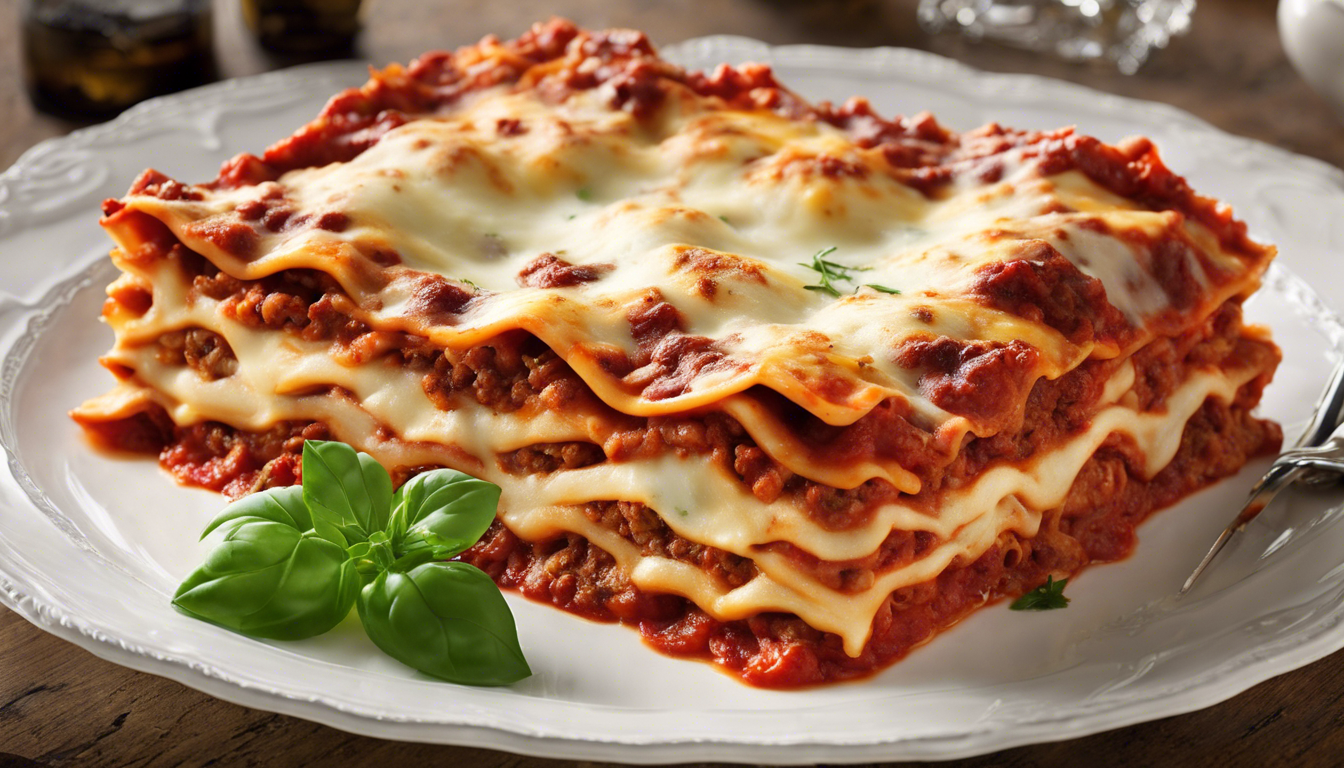
History and origins
Lasagna, a beloved dish in Italian cuisine, has a rich history that dates back to ancient times. The origins of lasagna can be traced to Ancient Greece, where a dish called “Laganon” was made with layers of pasta and sauce. However, the lasagna we know today began to take shape in Italy during the Middle Ages.
The word “lasagna” itself is derived from the Greek word “lasanon,” which means chamber pot. This term was later adopted by the Romans as “lasanum” to refer to a cooking pot. Over time, the term evolved to describe the dish cooked in the pot, eventually becoming synonymous with the layered pasta dish we enjoy today.
In the 14th century, the first recorded recipe for lasagna appeared in a cookbook called “Liber de Coquina,” written in Naples. This early version of lasagna was quite different from the modern dish, as it did not include tomatoes, which were not introduced to Europe until the 16th century. Instead, it featured layers of fermented dough, cheese, and spices.
As lasagna spread throughout Italy, regional variations began to emerge. In Northern Italy, particularly in Emilia-Romagna, lasagna is traditionally made with green spinach pasta, béchamel sauce, and a rich meat ragù. In Southern Italy, especially in Naples, lasagna is often made with ricotta cheese, mozzarella, and a simple tomato sauce.
Lasagna gained international popularity in the 20th century, particularly in the United States, where Italian immigrants introduced the dish. Today, lasagna is enjoyed worldwide and has inspired countless variations, from vegetarian and seafood versions to innovative twists like lasagna rolls and skillet lasagna.
The enduring appeal of lasagna lies in its versatility and the comforting combination of pasta, sauce, and cheese. Whether you prefer a classic meat lasagna or a creative new take on the dish, the history of lasagna is a testament to its timelessness and adaptability.
Ingredients and preparation
To create a classic lasagna, you’ll need a variety of ingredients that come together to form the rich layers of this beloved dish. Here’s a comprehensive list of what you’ll need:
- Lasagna noodles: 12-15 sheets, cooked according to package instructions
- Ground beef: 1 pound
- Italian sausage: 1/2 pound, casings removed
- Onion: 1 medium, finely chopped
- Garlic: 3 cloves, minced
- Tomato sauce: 2 cups
- Tomato paste: 6 ounces
- Crushed tomatoes: 1 can (28 ounces)
- Water: 1/2 cup
- Sugar: 2 tablespoons
- Dried basil: 1 teaspoon
- Fennel seeds: 1/2 teaspoon
- Italian seasoning: 1 teaspoon
- Salt: 1 teaspoon
- Black pepper: 1/2 teaspoon
- Ricotta cheese: 16 ounces
- Egg: 1 large
- Fresh parsley: 2 tablespoons, chopped
- Mozzarella cheese: 3 cups, shredded
- Parmesan cheese: 3/4 cup, grated
Now, let’s move on to the preparation of this delicious lasagna:
- Step 1: Preheat your oven to 375°F (190°C).
- Step 2: In a large skillet, cook the ground beef, Italian sausage, onion, and garlic over medium heat until the meat is browned and the onion is tender. Drain any excess fat.
- Step 3: Stir in the tomato sauce, tomato paste, crushed tomatoes, and water. Add the sugar, basil, fennel seeds, Italian seasoning, salt, and black pepper. Simmer the sauce for about 30 minutes, stirring occasionally.
- Step 4: In a mixing bowl, combine the ricotta cheese, egg, and fresh parsley. Mix well.
- Step 5: Spread 1 1/2 cups of the meat sauce in the bottom of a 9×13 inch baking dish. Arrange 6 lasagna noodles lengthwise over the sauce. Spread half of the ricotta cheese mixture over the noodles. Top with a third of the mozzarella cheese slices. Spoon 1 1/2 cups meat sauce over the mozzarella, and sprinkle with 1/4 cup Parmesan cheese.
- Step 6: Repeat the layers, and top with remaining mozzarella and Parmesan cheese.
- Step 7: Cover with foil (to prevent sticking, either spray foil with cooking spray, or make sure the foil does not touch the cheese).
- Step 8:
Variations and regional differences
There are numerous variations of lasagna that reflect the diverse culinary traditions of different regions. Each variation brings its own unique twist to the classic dish, showcasing local ingredients and flavors.
Lasagna alla Bolognese: This version hails from Bologna in the Emilia-Romagna region. It features layers of green spinach pasta, a rich ragù made with a mix of ground beef and pork, béchamel sauce, and Parmigiano-Reggiano cheese. The green pasta is made by incorporating spinach puree into the dough, giving it a distinctive color and flavor.
Lasagna Napoletana: Originating from Naples, this variation is known for its use of ricotta cheese, mozzarella, and a simple tomato sauce. It often includes small meatballs, hard-boiled eggs, and slices of Italian sausage, adding a hearty and flavorful touch to the dish.
Vegetarian Lasagna: For those who prefer a meatless option, vegetarian lasagna is a popular choice. This version typically includes layers of roasted vegetables such as zucchini, eggplant, and bell peppers, along with a tomato or béchamel sauce and a variety of cheeses like ricotta, mozzarella, and Parmesan.
Seafood Lasagna: A coastal twist on the classic, seafood lasagna incorporates ingredients like shrimp, crab, and scallops. The seafood is often combined with a creamy béchamel or Alfredo sauce, and layered with pasta and cheese. This variation is particularly popular in regions with access to fresh seafood.
Lasagna Bianca: Also known as white lasagna, this version omits the tomato sauce and instead uses a béchamel sauce as the base. It can be made with a variety of fillings, such as mushrooms, spinach, and chicken, and is often topped with a generous amount of cheese.
Mexican Lasagna: A fusion dish that combines the flavors of Italian and Mexican cuisine, Mexican lasagna uses tortillas instead of pasta sheets. The layers include seasoned ground beef or chicken, black beans, corn, salsa, and a blend of Mexican cheeses. It’s a spicy and flavorful alternative to traditional lasagna.
Lasagna Rolls: This innovative twist involves rolling individual lasagna noodles with the filling inside, rather than layering them. Each roll is filled with a mixture of ricotta cheese, spinach, and sometimes meat, then topped with sauce and cheese before baking. Lasagna rolls are perfect for portion control and make for an elegant presentation.
These variations demonstrate the versatility of lasagna and its ability to adapt to different tastes and ingredients. Whether you stick to the classic recipe or experiment with new flavors, lasagna remains a beloved dish that brings comfort and joy to the table.
